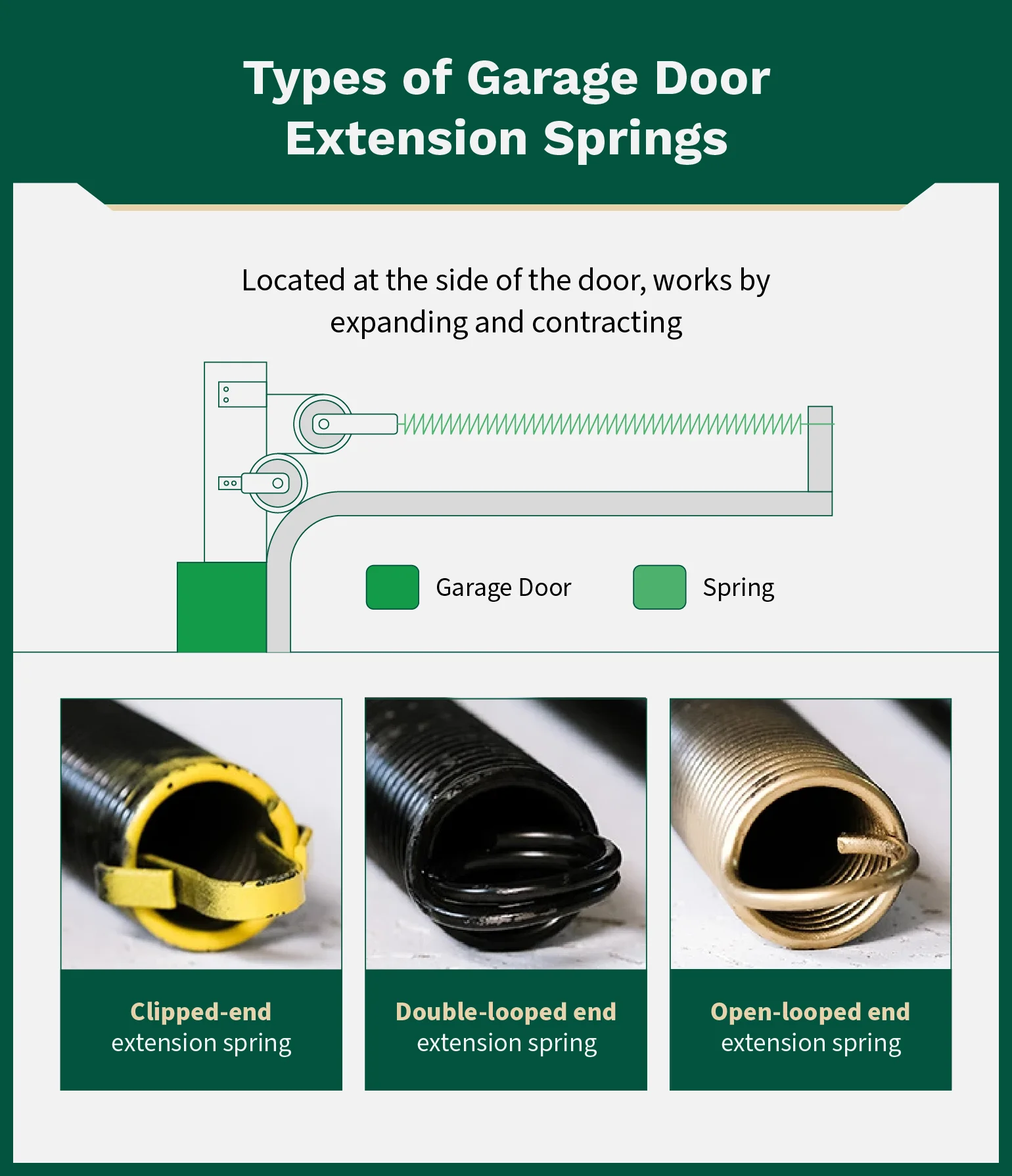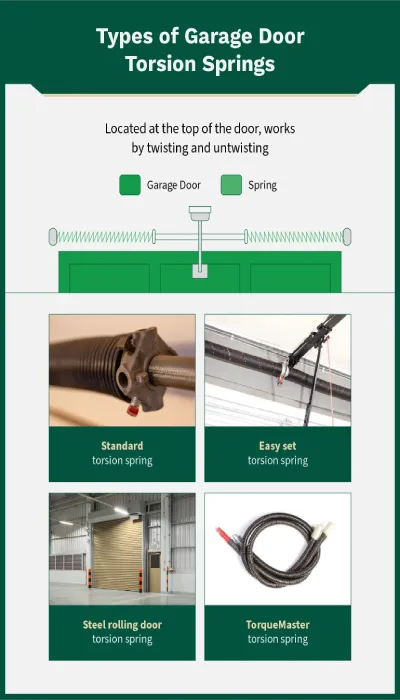
No one needs to be told twice that hearing a loud crash or bang coming from your garage is a bad sign.
A noise this calamitous can mean that the spring that helps raise and lower your door has broken — an important and dangerous repair that requires the experience and expertise of a professional. To make the garage door spring repair process easier, it helps to know the type of spring you need.
Whether you want to upgrade your spring to a safer model or learn more about spring maintenance, we’ll cover the types of garage door springs and how to identify them below.
Table of Contents:
- Extension Springs
- Torsion Springs
- How To Identify the Different Types of Garage Door Spring
- Torsion vs. Extension Springs: Which Is Best?
- Trust Precision Garage Door Service With Spring Replacement
- Garage Door Spring FAQs
Extension Springs
Extension springs connect to the pulleys alongside a garage door to help control lifting and lowering of the heavy door. As the name implies, this spring works by expanding and contracting. Think of the springs that hold the batteries in place in your remote — these are extension springs.
Your garage door uses extension springs if the springs:
- Run along the sides of the garage door
- End in loops
- Are connected to pulleys
There are three main types of extension springs, which are named based on the design of the part that connects to the pulley. Below, we review how each type is different.

- Clipped-end extension springs: Clipped-end extension springs are capped with a separate piece of metal that’s woven into either side of the spring end to form a loop. Because this metal is separate from the spring itself, these springs are the sturdiest type of extension spring.
- Double-looped end extension springs: Double-looped extension springs are capped by two spring layers bent outward to form a loop. These springs offer medium durability because the loop can pull and loosen the spring on the edges.
- Open-looped end extension springs: Open-looped extension springs are capped by one spring layer bent outward to form the loop. These are the least durable type because the loop is less protected against distortion when it’s used.
Torsion Springs
Torsion springs are connected to garage door cables at the top of the door. They use rotational tension to operate your door. If you’ve ever had a pair of kitchen tongs, you might have noticed a spring holds them open so you can grab items easier. That’s a torsion spring.
Your garage door uses torsion springs if the springs:
- Are located above your garage door
- End in metal pieces called cones
- Connect to a metal tube
If you have two springs, your left torsion spring may have red markings, and the right side may have a black marking.
Many garage door spring manufacturers color-code their springs. They do this to show which tension spring goes on which side. If you see these colors, you can be sure that you have garage door torsion springs.

- Standard torsion springs: Standard torsion springs are the most basic type of torsion spring. At each end of the spring, the wire is pulled straight. These straight sections are where the mechanisms apply force to create or release tension as the door opens and closes.
- Steel rolling door torsion springs: Steel rolling door torsion springs are manufactured to work with steel rolling garage doors. These doors operate slightly differently from other types of garage doors, so they require a specific type of spring.
- Easy set torsion springs: The early set torsion spring is similar to the standard torsion spring. However, it’s located in the middle of the torsion shaft.
- TorqueMaster torsion springs: The TorqueMaster system uses two springs, which are located inside a shaft, so they’re less likely to injure someone during repair service. However, these springs only last 3,000 to 5,000 cycles, compared to the 30,000 cycle-rated springs we use at Precision Garage Door Service™.
How To Identify the Different Types of Garage Door Spring
It’s important to know which spring your garage door has so you can spot the signs it should be replaced. Replacing a garage door spring is very dangerous, so schedule repair or replacement service with your local Precision Garage Door Service professional as soon as you notice any signs of wear.
Signs it’s time to replace a spring include:
- The door operates slower than usual.
- The door makes a loud noise when opening and closing.
- The door feels heavier and is harder to open during manual operation.
- The door hangs unevenly.
- The cables and/or springs appear loose.
Identifying torsion springs
Your garage door has a torsion spring if:
- The garage door spring is directly above your garage door: The word "torsion" comes from the Latin word meaning "to turn." To close your garage door, torsion springs twist. They will hold this position until you open your garage door.
- There’s a metal piece on each end of the spring: These metal ends form X's and are called cones. The type of cone on the spring determines how the service professional will wind the spring when they install it.
- There’s a metal shaft, called a torsion tube: These tubes can be hollow or solid and they connect to cable drums at each corner of your garage.
Identifying extension springs
Your garage door has an extension spring if:
- There’s a garage door spring running along each side of your garage: To close your garage door, extension springs extend outward, connecting to each side of the door.
- There are loops on the end of the spring: The three types of extension springs are open-looped end, double-looped end, and clipped-end.
- The springs connect to pulleys: These pulleys run along the walls of your garage. The pulleys connect to the garage door opener cables.
Torsion vs. Extension Springs: Which Is Best?
Coated torsion springs are the best option for your garage door. Torsion springs are safer than extension springs and often last twice as long. Coating on a torsion spring makes it last even longer than a regular torsion spring.
Torsion springs are also safer compared to extension springs because they’re self-contained. When they break, they will not turn into projectiles. Extension springs, however, can fire off. Building code requires that extension springs have safety cables so if an extension spring breaks, it will not shoot out.
Unfortunately, many companies and individuals don’t follow these rules. As a result, extension springs have destroyed garages and even killed people. If you’re concerned about safety, schedule a garage door tune-up for an inspection and expert advice about your door’s springs.
Springs with coating do not break as quickly. At Precision Garage Door Service, our proprietary e-coated torsion springs last five times longer than standard torsion springs.
Trust Precision Garage Door Service With Spring Replacement
In need of garage door maintenance or repair? Contact Precision Garage Door Service. One of our experienced garage door service professionals will come to your home, assess the problem, and review options with you. We always arrive in branded, fully stocked trucks with different types of garage door springs and repair parts, so your repair is done right on the first visit.

This article is intended for general informational purposes only and may not apply to every situation. You are responsible for determining the proper course of action for your property. Services should be performed by licensed and experienced professionals. Precision Garage Door Service is not responsible for any damages that occur as a result of this blog content or your actions. For the most accurate guidance, contact a Precision Garage Door Service professional for a comprehensive, on-site assessment.
FAQs About Garage Door Springs
As a garage door service, repair, and installation leader renowned for integrity and dependability, all independently owned and operated Precision Garage Door Service locations are committed to safety, quality workmanship, and your satisfaction. This commitment includes using our expertise and years of experience to answer your questions. Here are answers to some of the most frequently asked questions about garage door springs.
How can I tell if I need a garage door spring replacement?
Look for a few common signs that suggest it's time to replace your garage door springs:
- The door is difficult to lift or feels heavier than usual.
- The garage door opens unevenly or jerks during movement.
- You notice gaps in the spring coils.
- The door doesn’t stay open on its own.
- Loud snapping or popping sounds come from the springs.
If any of these issues occur, it’s likely time for a professional evaluation.
What’s the typical lifespan of garage door springs?
Most garage door springs are rated for 10,000 to 20,000 cycles (one cycle = one open and close). Depending on how often the door is used, that typically translates to 7–14 years. Torsion springs tend to last longer and offer smoother operation, while extension springs may need replacing sooner, especially in high-use households.
Can I replace garage door springs myself?
Do not attempt a DIY garage door spring replacement. Garage door springs are extremely high-tension components that can cause serious injury if mishandled. Specialized tools and training are needed to do the job safely. For your safety and the longevity of your system, leave spring replacement to a trained service professional.
Is it necessary to replace both garage door springs if only one is broken?
Yes—replace both garage door springs at the same time. Springs work as a pair and wear down at the same rate. Installing a new spring alongside an older one can lead to imbalance, uneven strain on the door, and premature failure of the new spring.
How much does garage door spring replacement usually cost?
On average, garage door spring replacement costs range from $150 to $350 for a single spring; however, prices can vary depending on the type of spring, door size, and labor. Larger or double doors and specialty parts may raise the total. A professional inspection can provide a more accurate quote.
How do I know if my garage door springs are the right size?
Proper sizing depends on several factors, including the door's weight, height, and system setup. The garage door spring size is critical for a balanced operation, but measuring the spring's coil diameter, wire size, and overall length is complex. An experienced professional can determine the correct specifications and recommend the best replacement.
What’s the difference between torsion and extension garage door springs?
Your garage setup and usage will determine whether torsion or tension garage door springs are ideal.
- Torsion springs: Mounted above the garage door; lifting action powered by torque. They offer smoother, quieter operation and longer lifespan, but cost more than extension springs and take up more overhead space in the garage.
- Extension springs: Stretch along the sides of the door; more common on older or lighter systems. They are more affordable and easier to install than torsion springs, but tend to be noisier and have a higher chance of failure.
Is it safe to use my garage door if a spring is broken?
No. Operating a garage door with a broken spring can damage the opener, strain other components, or result in a sudden door collapse. If a spring breaks, stop using the door immediately and have it inspected by a professional.
Need help with your garage door springs?
Whether you're dealing with a broken spring or simply want a professional opinion, timely garage door spring replacement can prevent bigger issues. Schedule an appointment with a local service professional to restore your system's safety and reliability.